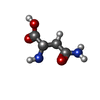[English] 日本語
 Yorodumi
Yorodumi- PDB-1jaz: Crystal Structure of Monoclinic Form of D90E Mutant of Escherichi... -
+ Open data
Open data
- Basic information
Basic information
| Entry | Database: PDB / ID: 1jaz | ||||||
|---|---|---|---|---|---|---|---|
| Title | Crystal Structure of Monoclinic Form of D90E Mutant of Escherichia coli Asparaginase II | ||||||
 Components Components | L-ASPARAGINASE II | ||||||
 Keywords Keywords | HYDROLASE / L-asparaginase / leukemia / zinc-binding site | ||||||
| Function / homology |  Function and homology information Function and homology informationL-asparagine catabolic process / asparaginase / asparaginase activity / outer membrane-bounded periplasmic space / protein homotetramerization / periplasmic space / protein-containing complex / identical protein binding Similarity search - Function | ||||||
| Biological species |  | ||||||
| Method |  X-RAY DIFFRACTION / X-RAY DIFFRACTION /  SYNCHROTRON / SYNCHROTRON /  MOLECULAR REPLACEMENT / Resolution: 2.27 Å MOLECULAR REPLACEMENT / Resolution: 2.27 Å | ||||||
 Authors Authors | Borek, D. / Kozak, M. / Jaskolski, M. | ||||||
 Citation Citation |  Journal: Febs J. / Year: 2014 Journal: Febs J. / Year: 2014Title: Crystal structure of active site mutant of antileukemic L-asparaginase reveals conserved zinc-binding site. Authors: Borek, D. / Kozak, M. / Pei, J. / Jaskolski, M. #1:  Journal: Proc.Natl.Acad.Sci.USA / Year: 1993 Journal: Proc.Natl.Acad.Sci.USA / Year: 1993Title: Crystal Structure of Escherichia coli L-Asparaginase, An Enzyme Used in Cancer Therapy Authors: Swain, A.L. / Jaskolski, M. / Housset, D. / Rao, J.K. / Wlodawer, A. #2:  Journal: FEBS Lett. / Year: 1996 Journal: FEBS Lett. / Year: 1996Title: A Covalently Bound Catalytic Intermediate in Escherichia coli Asparaginase: Crystal Structure of a Thr-89-Val Mutant Authors: Palm, G.J. / Lubkowski, J. / Derst, C. / Schleper, S. / Rohm, K.H. / Wlodawer, A. #3:  Journal: ACTA CRYSTALLOGR.,SECT.D / Year: 2001 Journal: ACTA CRYSTALLOGR.,SECT.D / Year: 2001Title: Structures of Two Highly Homologous Bacterial L-Asparaginases: a Case of Enantiomorphic Space Groups Authors: Jaskolski, M. / Kozak, M. / Lubkowski, J. / Palm, G. / Wlodawer, A. #4:  Journal: ACTA BIOCHIM.POL. / Year: 1997 Journal: ACTA BIOCHIM.POL. / Year: 1997Title: Why a "Benign" Mutation Kills Enzyme Activity. Structure-based Analysis of the A176V Mutant of Saccharomyces cerevisiae L-Asparaginase I Authors: Bonthron, D.T. / Jaskolski, M. #5:  Journal: BIOCHIM.BIOPHYS.ACTA / Year: 2000 Journal: BIOCHIM.BIOPHYS.ACTA / Year: 2000Title: Dynamics of a mobile loop at the active site of Escherichia coli Asparaginase Authors: Aung, H.P. / Bocola, M. / Schleper, S. / Rohm, K.H. | ||||||
| History |
| ||||||
| Remark 300 | BIOMOLECULE: 1 THIS ENTRY CONTAINS THE CRYSTALLOGRAPHIC ASYMMETRIC UNIT WHICH CONSISTS OF 2 CHAIN(S) ...BIOMOLECULE: 1 THIS ENTRY CONTAINS THE CRYSTALLOGRAPHIC ASYMMETRIC UNIT WHICH CONSISTS OF 2 CHAIN(S). SEE REMARK 350 FOR INFORMATION ON GENERATING THE BIOLOGICAL MOLECULE(S). THE BIOLOGICALLY SIGNIFICANT OLIGOMER IS A HOMOTETRAMER WITH 222 SYMMETRY. THE ASYMMETRIC UNIT CONSIST OF MONOMERS A AND B. THE ACTIVE-SITE-COMPETENT DIMERS (A/A' AND B/B') ARE CREATED THROUGH CRYSTALLOGRAPHIC TWO-FOLD ROTATION. |
- Structure visualization
Structure visualization
| Structure viewer | Molecule:  Molmil Molmil Jmol/JSmol Jmol/JSmol |
|---|
- Downloads & links
Downloads & links
- Download
Download
| PDBx/mmCIF format |  1jaz.cif.gz 1jaz.cif.gz | 127.7 KB | Display |  PDBx/mmCIF format PDBx/mmCIF format |
|---|---|---|---|---|
| PDB format |  pdb1jaz.ent.gz pdb1jaz.ent.gz | 99.6 KB | Display |  PDB format PDB format |
| PDBx/mmJSON format |  1jaz.json.gz 1jaz.json.gz | Tree view |  PDBx/mmJSON format PDBx/mmJSON format | |
| Others |  Other downloads Other downloads |
-Validation report
| Summary document |  1jaz_validation.pdf.gz 1jaz_validation.pdf.gz | 442.3 KB | Display |  wwPDB validaton report wwPDB validaton report |
|---|---|---|---|---|
| Full document |  1jaz_full_validation.pdf.gz 1jaz_full_validation.pdf.gz | 452.9 KB | Display | |
| Data in XML |  1jaz_validation.xml.gz 1jaz_validation.xml.gz | 24.1 KB | Display | |
| Data in CIF |  1jaz_validation.cif.gz 1jaz_validation.cif.gz | 34 KB | Display | |
| Arichive directory |  https://data.pdbj.org/pub/pdb/validation_reports/ja/1jaz https://data.pdbj.org/pub/pdb/validation_reports/ja/1jaz ftp://data.pdbj.org/pub/pdb/validation_reports/ja/1jaz ftp://data.pdbj.org/pub/pdb/validation_reports/ja/1jaz | HTTPS FTP |
-Related structure data
| Related structure data |  1ihdC  1jjaC  3ecaS C: citing same article ( S: Starting model for refinement |
|---|---|
| Similar structure data |
- Links
Links
- Assembly
Assembly
| Deposited unit | 
| ||||||||
|---|---|---|---|---|---|---|---|---|---|
| 1 | 
| ||||||||
| Unit cell |
| ||||||||
| Components on special symmetry positions |
| ||||||||
| Details | The biological assembly is a homotetramer. The asymmetric unit contains two asparaginase monomers. The complete tetramer is generated by crystallographic two-fold rotation which relates the two subunits necessary for the creation of the active site. |
- Components
Components
| #1: Protein | Mass: 34640.836 Da / Num. of mol.: 2 / Mutation: D90E Source method: isolated from a genetically manipulated source Source: (gene. exp.)   #2: Chemical | #3: Water | ChemComp-HOH / | Has protein modification | Y | |
|---|
-Experimental details
-Experiment
| Experiment | Method:  X-RAY DIFFRACTION / Number of used crystals: 2 X-RAY DIFFRACTION / Number of used crystals: 2 |
|---|
- Sample preparation
Sample preparation
| Crystal | Density Matthews: 2.1 Å3/Da / Density % sol: 40.5 % |
|---|---|
| Crystal grow | Temperature: 293 K / Method: vapor diffusion, hanging drop / pH: 6.5 Details: PEG MME 550, MES, zinc sulfate, pH 6.5, 292 K, VAPOR DIFFUSION, HANGING DROP, temperature 293K |
-Data collection
| Diffraction | Mean temperature: 100 K |
|---|---|
| Diffraction source | Source:  SYNCHROTRON / Site: SYNCHROTRON / Site:  MAX II MAX II  / Beamline: I711 / Wavelength: 1.104 Å / Beamline: I711 / Wavelength: 1.104 Å |
| Detector | Type: MARRESEARCH / Detector: IMAGE PLATE / Date: Mar 21, 1999 / Details: Vertically focusing cylindrical pre-mirror |
| Radiation | Monochromator: Single asymmetrically cut Si(111) crystal with horizontal diffraction plane. The crystal is bendable for horizontal focusing. Protocol: SINGLE WAVELENGTH / Monochromatic (M) / Laue (L): M / Scattering type: x-ray |
| Radiation wavelength | Wavelength: 1.104 Å / Relative weight: 1 |
| Reflection | Resolution: 2.27→25 Å / Num. all: 26057 / Num. obs: 26057 / % possible obs: 98.6 % / Observed criterion σ(F): 0 / Observed criterion σ(I): -3 / Redundancy: 4.9 % / Biso Wilson estimate: 36.4 Å2 / Rmerge(I) obs: 0.098 / Net I/σ(I): 28.9 |
| Reflection shell | Resolution: 2.27→2.35 Å / Redundancy: 2.9 % / Rmerge(I) obs: 0.143 / Mean I/σ(I) obs: 6.2 / % possible all: 87.3 |
- Processing
Processing
| Software |
| ||||||||||||||||||||||||||||||||||||||||||||||||||||||||||||||||||||||||||||||||||||
|---|---|---|---|---|---|---|---|---|---|---|---|---|---|---|---|---|---|---|---|---|---|---|---|---|---|---|---|---|---|---|---|---|---|---|---|---|---|---|---|---|---|---|---|---|---|---|---|---|---|---|---|---|---|---|---|---|---|---|---|---|---|---|---|---|---|---|---|---|---|---|---|---|---|---|---|---|---|---|---|---|---|---|---|---|---|
| Refinement | Method to determine structure:  MOLECULAR REPLACEMENT MOLECULAR REPLACEMENTStarting model: MONOMER A FROM NATIVE L-ASPARAGINASE II STRUCTURE - PDB CODE: 3ECA Resolution: 2.27→10 Å / SU B: 11.03497 / SU ML: 0.27657 / Cross valid method: THROUGHOUT / σ(F): 0 / σ(I): -3 / ESU R: 0.38927 / ESU R Free: 0.23674 / Stereochemistry target values: ENGH AND HUBER Details: Maximum likelihood method and TLS parameters were used. Residues 15-35 of monomer A and residues 15-37 of monomer B are not included in the model because of poor electron density and ...Details: Maximum likelihood method and TLS parameters were used. Residues 15-35 of monomer A and residues 15-37 of monomer B are not included in the model because of poor electron density and possible disorder.EACH SUBUNIT (A AND B) COORDINATES ONE ZINC ION. ANOTHER ZINC CATION (AT HALF OCCUPANCY) IS LOCATED CLOSE TO THE CRYSTALLOGRAPHIC TWO-FOLD AXIS AND IS COORDINATED BY TWO COPIES OF SUBUNIT B.
| ||||||||||||||||||||||||||||||||||||||||||||||||||||||||||||||||||||||||||||||||||||
| Displacement parameters | Biso mean: 22.56 Å2
| ||||||||||||||||||||||||||||||||||||||||||||||||||||||||||||||||||||||||||||||||||||
| Refinement step | Cycle: LAST / Resolution: 2.27→10 Å
| ||||||||||||||||||||||||||||||||||||||||||||||||||||||||||||||||||||||||||||||||||||
| Refine LS restraints |
|
 Movie
Movie Controller
Controller



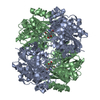

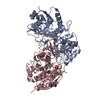



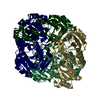


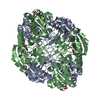

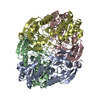


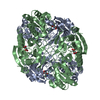

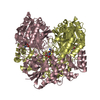
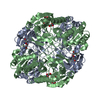

 PDBj
PDBj